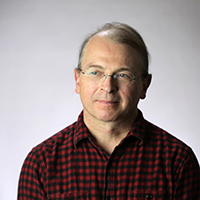
CQE PI Feature – Seth Lloyd
Exploring the role of information in the universe
Featured in QSEC May newsletter 2024
As a child I was fascinated by mathematical patterns in nature — veins of leaves, stripes on cat fur, ripples in sand. My early physics classes claimed that complex phenomena could be described at bottom by a few simple laws — what Eugene Wigner called, `the unreasonable effectiveness of mathematics in the natural sciences.’ Later, like all graduate students, I discovered that much of this apparent simplicity was in fact an illusion: digging into a complex structure frequently reveals an even more complex structure underneath. But it was too late: I was already hooked.
As an undergraduate at Harvard I wound magnets for Norman Ramsey and soldered high-voltage circuit boards for Carlo Rubbia on the experiment that discovered the W particle. But I had no stomach for working in giant experiments where the author list is longer than the paper. When I expressed my desire to work on high-energy theory to my advisor, Shelly Glashow, he said, `Why? It’s all been done’ (the implication being, `done by him’).
After college, I went to Cambridge on a Marshall Scholarship. I had never understood this quantum funny business about electrons being in two places at once, and I reasoned that if I studied the philosophy of quantum mechanics, such quantum weirdness would become less counterintuitive. (How wrong I was!) In 1984, my second year at Cambridge, I pursued an M.Phil. in History and Philosophy of Science with Jeremy Butterfield, focusing on problems of foundations of quantum mechanics and information theory (there was no field called `quantum information’ at that time). At the same time, inspired by Stephen Hawking’s graduate seminar on quantum gravity, I started trying to construct a theory of quantum gravity out of patterns of entanglement in what are now called qubits.
The first day of my Ph.D. in theoretical physics at Rockefeller University, my department chair asked me what I wanted to work on. `Information and foundations of quantum mechanics,’ I said. `Ha!’ he said, `Foundations of quantum mechanics?That’s only for crackpots and Nobel Laureates who have gone soft in the head!’
Given the current respectability of the field of quantum information, it’s hard to remember that before 1990, questions about quantum foundations were way out on the fringe. The bad part of working on the fringe was that it was almost impossible to find a job. The good part was that the small, supportive community of scientists who regarded such foundational questions as fundamental – including Rolf Landauer, Charlie Bennett, Wojciech Zurek, John Wheeler, Bill Wootters, Asher Peres, Daniel Greenberger, Anton Zeilinger, and others – took me in as one of their own.
With the help of my supervisor, Heinz Pagels, I made it through my Ph.D., and in 1988, Murray Gell-Mann offered me a postdoc at Caltech. In addition to working with Murray on ideas of information theory and complexity, I began to work out how to build a quantum computer. At that time there were only half-dozen papers on quantum computation, starting with the pioneering work of Benioff, Feynman, and Deutsch. But as Feynman said in one of his talks,`None of us has a clue how to build one.’
After years of false starts, in 1993 I figured out how to construct a quantum computer by taking arrays of atoms, electron spins, quantum dots, etc., and zapping them with lasers or microwave pulses to perform sequences of quantum logic operations. Which is how you construct a quantum computer today.
In 1994 I joined the faculty of Mechanical Engineering at MIT – no Physics departments would even interview me! – and began working with experimentalists to realize quantum computers: with Jeff Kimble to build the first atom-optical quantum logic gate; with Ike Chuang, Neil Gershenfeld, and Dave Cory to perform the first quantum algorithms; with Hermann Haus, Jeff Shapiro and Franco Wong to work out the theory of quantum communication and quantum imaging; with Selim Shahriar to make the first architecture for NV-diamond quantum information processing; with Hans Mooij, Terry Orlando, Leonya Levitov, Karl Berggren and Will Oliver to build some of the first superconducting qubits. Peter Shor came to MIT, and Eddie Farhi, Jeffrey Goldstone, Paula Cappellaro and many other researchers joined the quantum party, making MIT the most comprehensive and productive research institution in quantum information in the world.
We’ve gone through the quantum Medieval Era (pre 1994), the Renaissance (Shor’s algorithm and the development of simple quantum computing technologies), and the Enlightenment (scaling of quantum technologies to many qubits and dramatically increased coherence). The current quantum era can be compared to the early industrial era, before Watt’s governor made steam power practical. The goal of QSEC is to bring together quantum scientists and students together with industry to devise and implement societally useful applications. To do so will require new algorithms, new methods for quantum error corrections, and significant improvements in the precision and scalability of quantum technologies. Will we succeed in building societally useful quantum computers? Let’s try: now’s the time!




Copyright © 2022-2023 MIT Center for Quantum Engineering – all rights reserved – Accessibility


